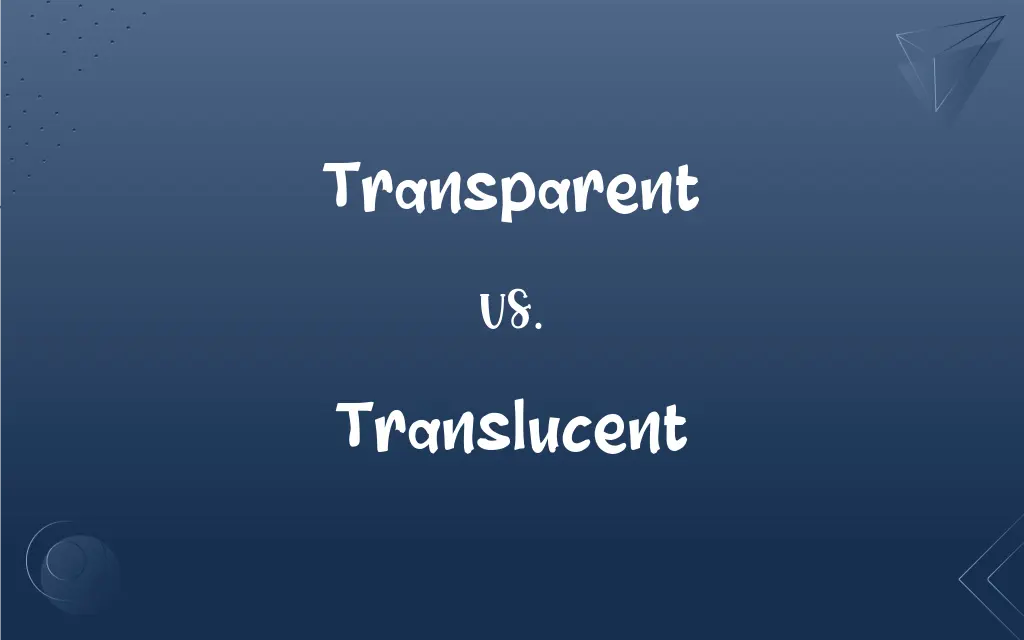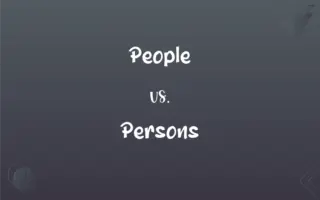Transparent vs. Translucent: What's the Difference?
Edited by Aimie Carlson || By Harlon Moss || Updated on October 13, 2023
Transparent materials allow all light to pass through without altering its direction, while translucent materials let light pass through but scatter it in different directions.

Key Differences
Transparent materials have the distinct quality of allowing light to pass through them without significantly scattering, distorting, or altering the light waves. Such materials are often crystal clear, providing an unhindered view of objects placed behind them. On the other hand, translucent materials also permit light to pass through, yet they diffuse the light, making objects behind them appear blurry or obscured.
The word transparent emanates from the Latin “transparens,” where “trans-” denotes through and “-parens” points to appearing or showing. Transparent objects are characterized by the clarity and sharpness with which one can perceive objects through them. In contrast, the term translucent originates from the Latin “translucentem,” involving “trans-” meaning through and “lucentem” signifying shining. Objects or materials that are translucent allow light to shine through but scatter it in various ways, preventing a clear view of what lies beyond.
In practical applications, the distinction between transparent and translucent materials is pivotal. Transparent materials, like clear glass or certain plastics, are widely utilized when visual access through the material is necessary, such as windows or eyewear lenses. Translucent materials, such as frosted glass or wax paper, are applied where light permeation is desired without revealing distinct images of objects behind them.
An interesting occurrence to note is that certain materials can exhibit both transparent and translucent properties depending on the specific conditions or their treatment. For example, glass can be transparent in its usual form, yet when it undergoes processes like sandblasting or frosting, it becomes translucent, scattering light and blurring objects seen through it. Similarly, some plastics can be manipulated or treated in a way that alters their level of transparency or translucency.
In a technological context, both transparency and translucency play crucial roles in varied applications. Transparent materials are imperative for optical instruments like microscopes, telescopes, and cameras, where clear, undistorted viewing is essential. Meanwhile, translucent materials find uses in contexts like lampshades or privacy partitions, where the goal is to diffuse light and shield or obscure the view into a certain space.
ADVERTISEMENT
Comparison Chart
Light Passage
Allows all light to pass through
Allows light to pass through but scatters it
Visibility of Objects
Objects are clearly visible
Objects are not clearly visible
Image Clarity
Produces a sharp and clear image
Produces a blurry or obscured image
Usage Example
Used for clear viewing, e.g., windows
Used to diffuse light, e.g., frosted windows
Material Example
Clear glass
Frosted glass
ADVERTISEMENT
Transparent and Translucent Definitions
Transparent
In a metaphorical sense, transparent can refer to being easily perceived or detected.
Her happiness was transparent, visible in her bright, sparkling eyes.
Translucent
Translucent objects blur or distort images of objects placed behind them due to light scattering.
The artist utilized a translucent layer of paint to create a dreamy, ethereal effect.
Transparent
Being transparent implies offering no impedance to sight and showcasing a clear, unobstructed view.
His transparent eyewear did not obstruct his sight in any way.
Translucent
Translucent materials permit light to pass through while diffusing it to obscure clear visibility.
The translucent curtain allowed light to fill the room but protected our privacy.
Transparent
Transparent is characterized by the unhindered passage of light and clear visibility of objects behind.
The transparent glass window provided a clear view of the garden outside.
Translucent
Translucent materials often function as semi-barriers, partially revealing and partially concealing what lies behind them.
The translucent fabric of her veil delicately hid and revealed her features at the same time.
Transparent
Transparent is describing a material or medium that does not alter the color or properties of light passing through it.
Scientists used a transparent liquid in the experiment to observe chemical reactions without interference.
Translucent
Being translucent implies allowing light penetration while preventing the perception of distinct images.
The translucent frosted glass provided a soft, diffused illumination to the space.
Transparent
Transparent can also denote something that is evident and leaves no doubt.
The politician’s transparent motive was criticized by the public.
Translucent
Something that is translucent tends to soften and spread light, often utilized for aesthetic or practical light diffusion.
The translucent paper gently softened the bright light coming from the lamp.
Transparent
Capable of transmitting light so that objects or images can be seen as if there were no intervening material.
Translucent
Transmitting light but causing sufficient diffusion to prevent perception of distinct images.
Transparent
Permeable to electromagnetic radiation of specified frequencies, as to visible light or radio waves.
Translucent
Allowing light to pass through, but diffusing it.
FAQs
Can a material be both transparent and translucent?
Yes, some materials can exhibit both properties depending on conditions or treatments like coatings.
Is clear glass transparent or translucent?
Clear glass is typically transparent as it allows clear, unobstructed visibility through it.
Can transparent materials alter the color of light passing through?
No, transparent materials do not significantly alter the color or characteristics of light.
Why might architects choose translucent materials?
To allow light into spaces while maintaining privacy or controlling glare and direct sunlight.
Is the human eye completely transparent?
The cornea and lens of the human eye are transparent, but other parts are not.
What does transparent mean?
Transparent refers to a material allowing light to pass through so that objects behind can be distinctly seen.
How does translucent differ from transparent?
Translucent allows light through but scatters it, causing objects behind to appear blurred or obscured.
Can transparent objects cast a shadow?
Typically, fully transparent objects do not cast shadows, but those with impurities or colors may cast faint shadows.
What are some common uses of transparent materials?
Windows, lenses, and screens often use transparent materials for clear visibility.
Can you give an example of a translucent object?
Frosted glass, used in some windows and shower doors, is a common translucent object.
Does the thickness of a material affect its transparency?
Yes, increasing thickness, especially in certain materials, can reduce transparency.
Why are some objects translucent?
Objects are translucent because their material scatters light, preventing a clear view through them.
Is it possible to make transparent materials translucent?
Yes, through processes like sandblasting or applying coatings, transparent materials can be made translucent.
Are all liquids transparent?
No, while many liquids like water are transparent, others, especially those with particles, may be translucent or opaque.
How does light interact with transparent materials?
Light passes through transparent materials without significant scattering or absorption, maintaining clarity.
How does a translucent material affect the brightness of light?
Translucent materials generally soften and reduce the brightness of light passing through by scattering it.
In what applications might both transparent and translucent materials be used together?
In some architectural or design applications, like certain light fixtures or privacy panels, both materials might be utilized for varied light and visibility control.
Why do translucent materials blur images?
They blur images due to the scattering of light as it passes through.
How do optical properties differ between transparent and translucent materials?
Transparent materials maintain light direction and clarity, while translucent materials scatter light and obscure clarity.
Are there degrees of translucency?
Yes, different materials can exhibit varying degrees of translucency based on their composition and thickness.
About Author
Written by
Harlon MossHarlon is a seasoned quality moderator and accomplished content writer for Difference Wiki. An alumnus of the prestigious University of California, he earned his degree in Computer Science. Leveraging his academic background, Harlon brings a meticulous and informed perspective to his work, ensuring content accuracy and excellence.
Edited by
Aimie CarlsonAimie Carlson, holding a master's degree in English literature, is a fervent English language enthusiast. She lends her writing talents to Difference Wiki, a prominent website that specializes in comparisons, offering readers insightful analyses that both captivate and inform.































































